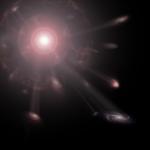
Courtesy of Pontoazul
Once the temperature and the bolometric luminosity of a star are known, its size can easily be calculated using Planck's formula. This formula gives the total emission of radiant energy per unit area for a hot body's surface at each temeperature. Radii of stars have been found to vary from 1/100 that of the sun, generally white dwarfs, to 400 times the radius of the sun, being a supergiant. More than half of the total stars are in binary or multuiple star systems and about 100 orbits in these systems have been accurately recorded providing one of the star's most important characteristics, its mass. Using Newton's Law of Gravitation, the mass of a star in a binary system can be accurately measured by measuring the period of orbit. Also if these stars happen to eclipse, then their diameters can accurately be recorded. Our Sun's mass is about 2x10^33 g or about 333,000 times the mass of Earth. Oribts of binary stars have been found the mass of some stars to be from 40 to 1/10 the mass of the Sun.
Luminosity also is related to the mass of a star. It is found that a high mass star will have high luminosity and a low mass star will have low luminosity. Mass and luminosity are related by the term, Mass-Luminosity Relation and are proportional to mass^3.5. In example a star 3 times the mass of the Sun will have luminosity 3^3.5 that of the sun.
Stellar Structure


Courtesy of:
NASA
The internal structure of a star is almost entirely theoretical and based upon laboratory measurements of gases. The calculations of structure are based on the two principles of convection equilibrium, in which turbulence brings the energy outwards andradiative equilibrium, in which radiation brings the energy outward. The actual temperature and density are calculated for each depth using characteristics of the mix of gases (hydrogen, helium, and heavier elements exposed by spectrum).